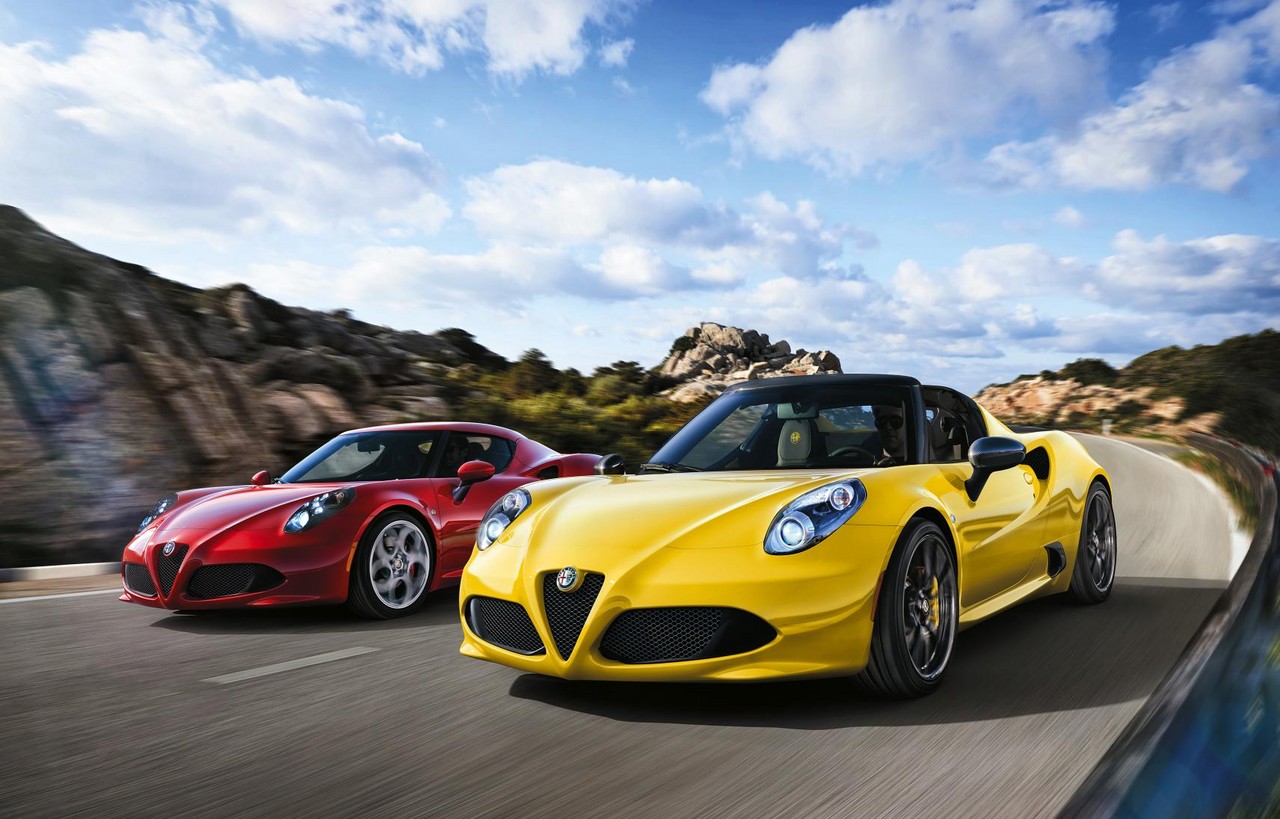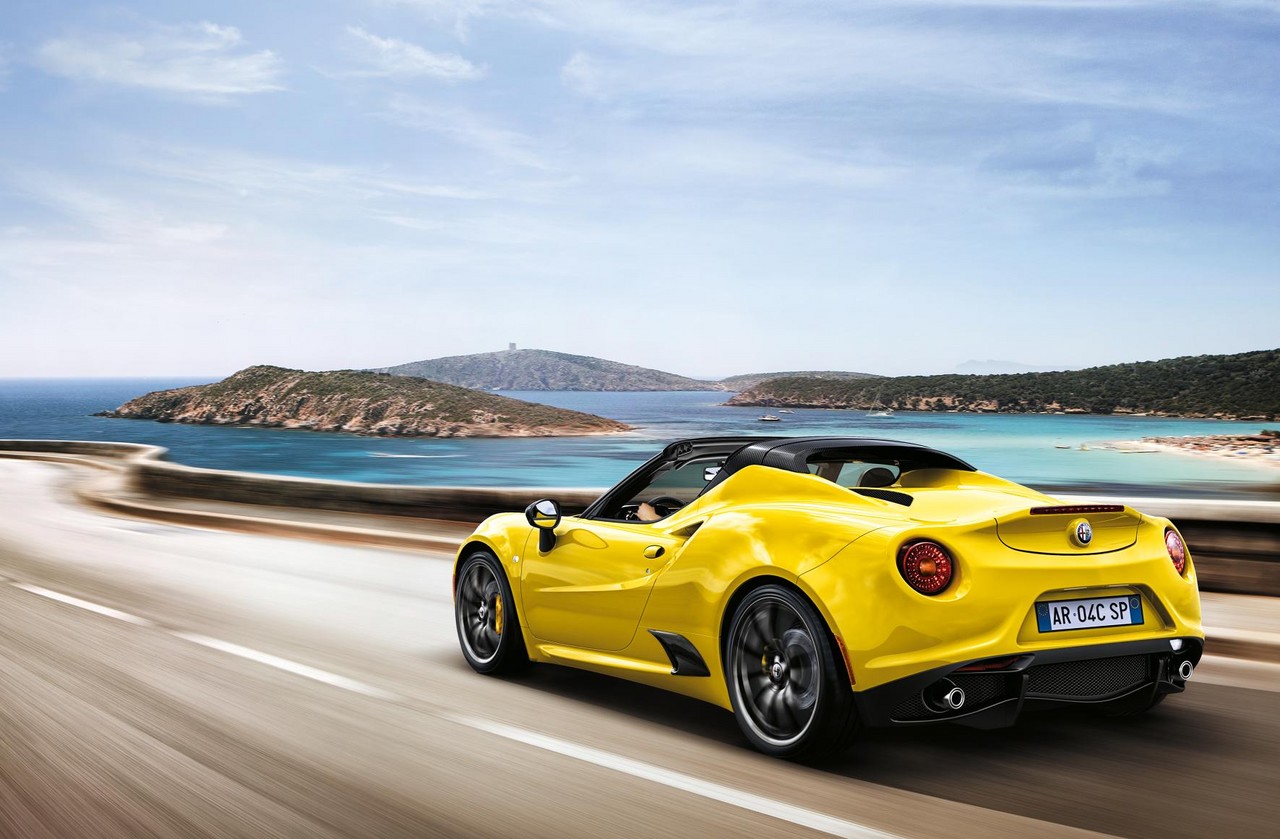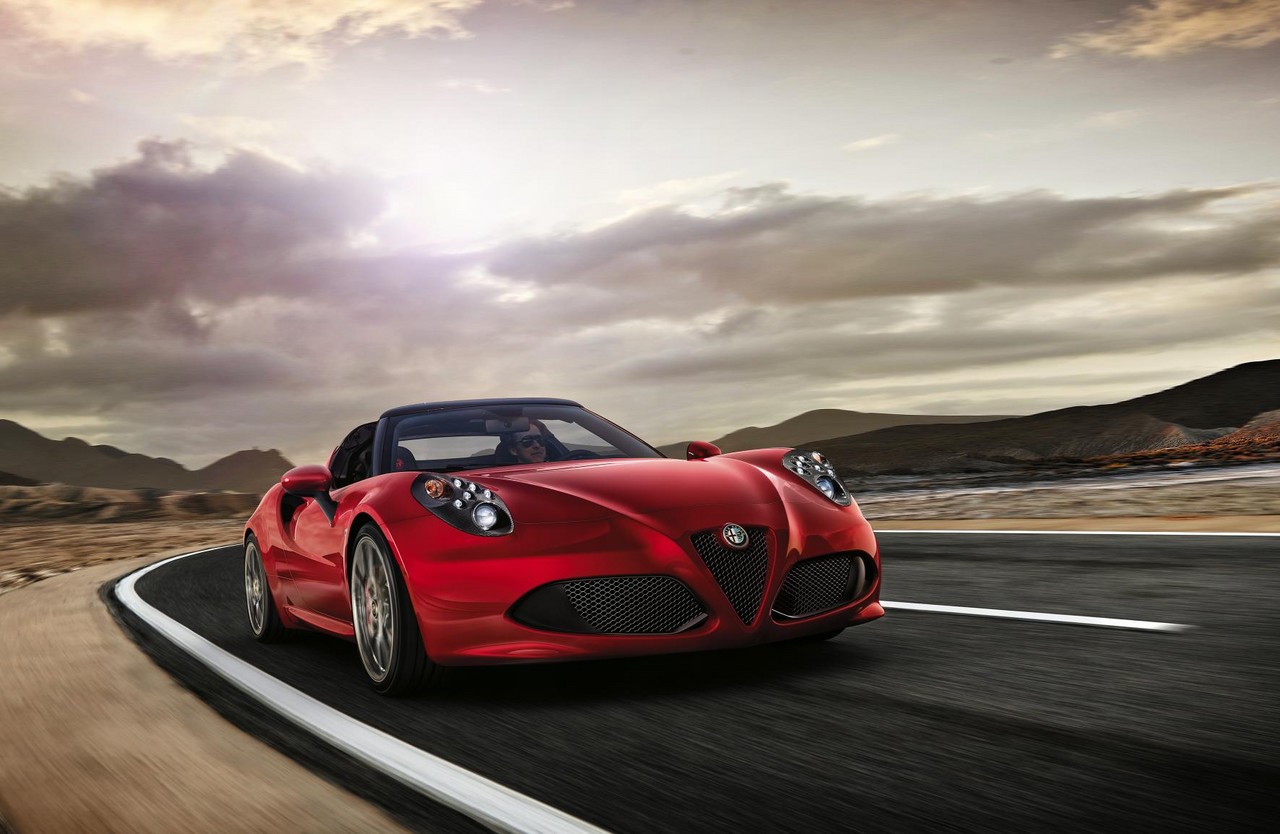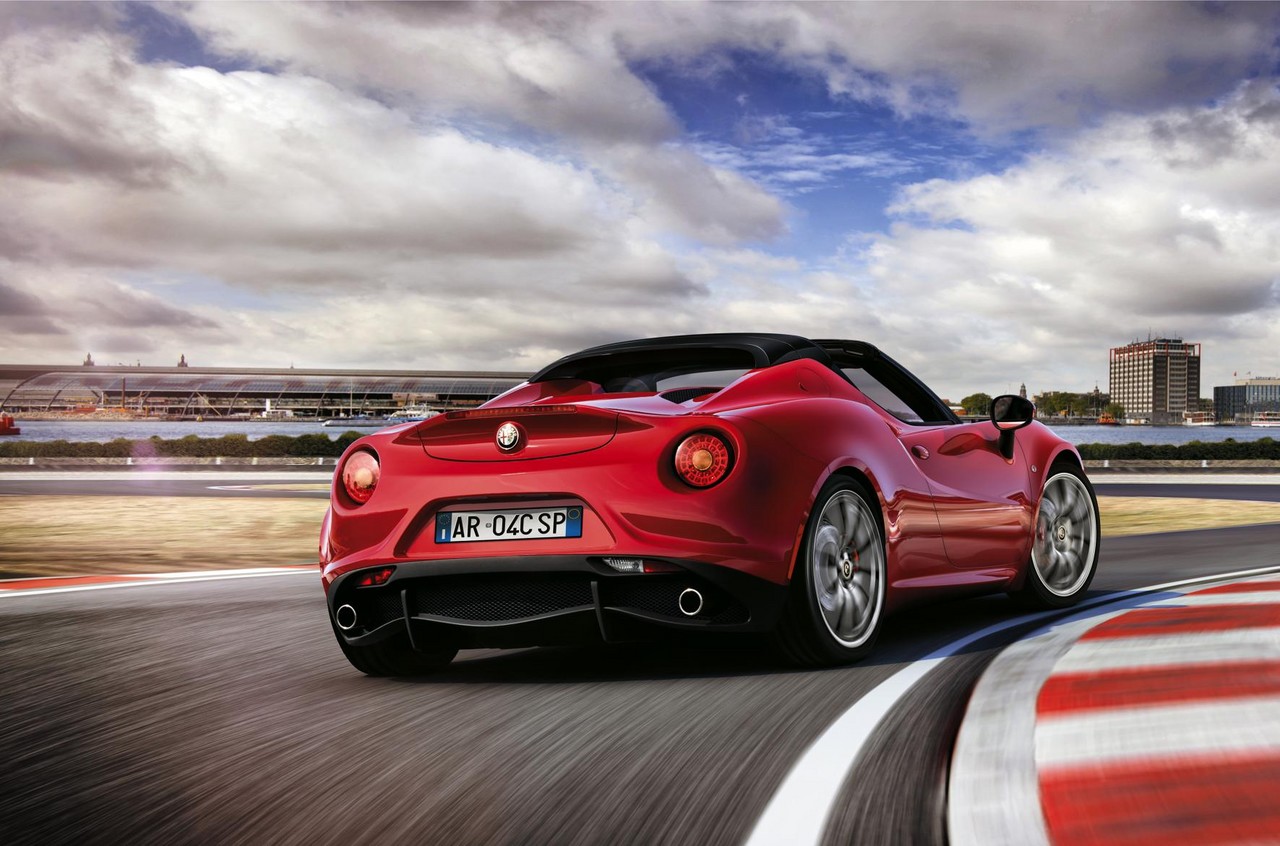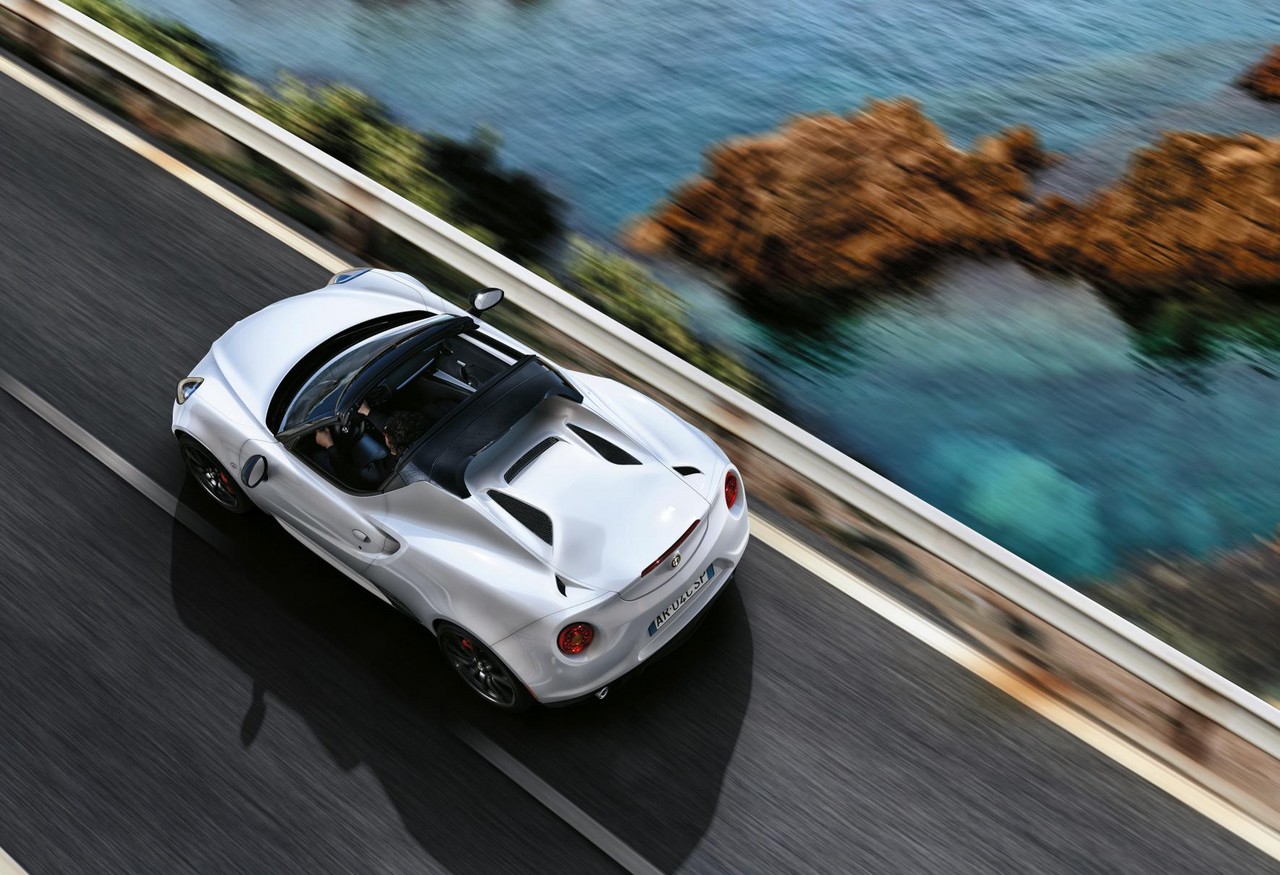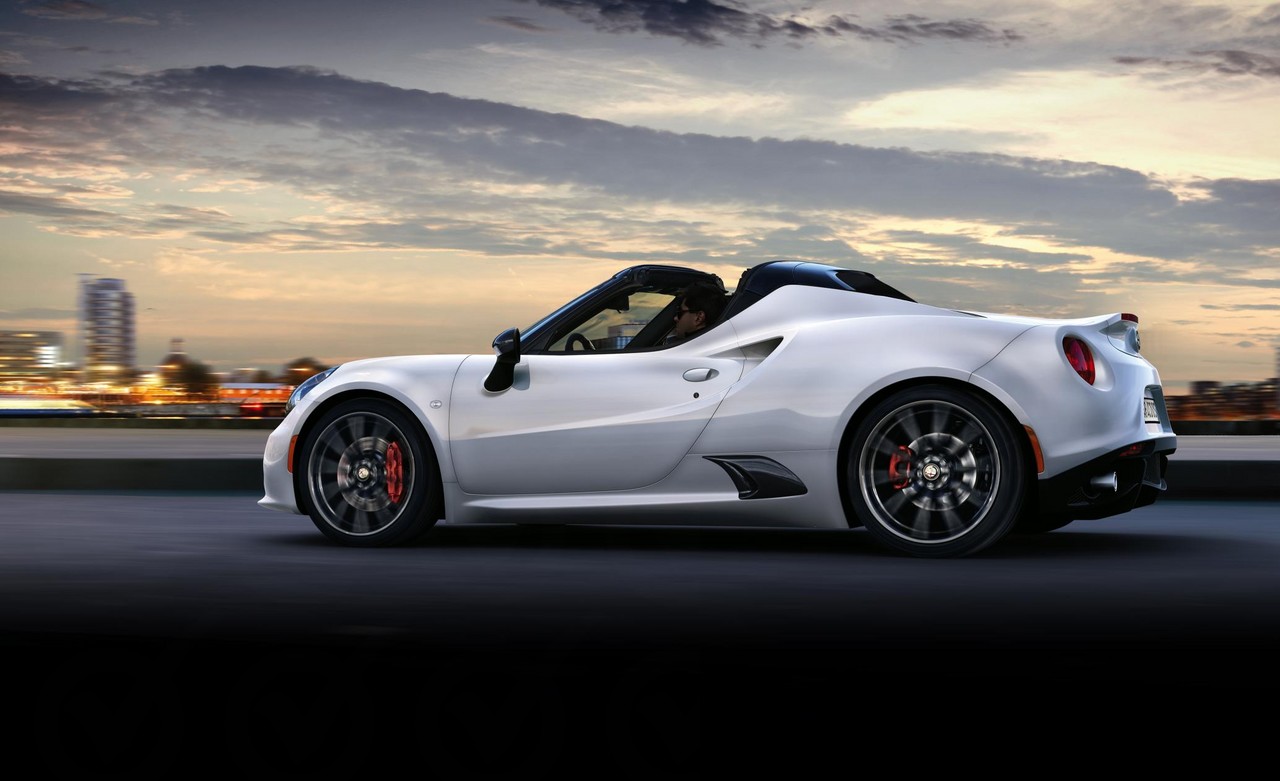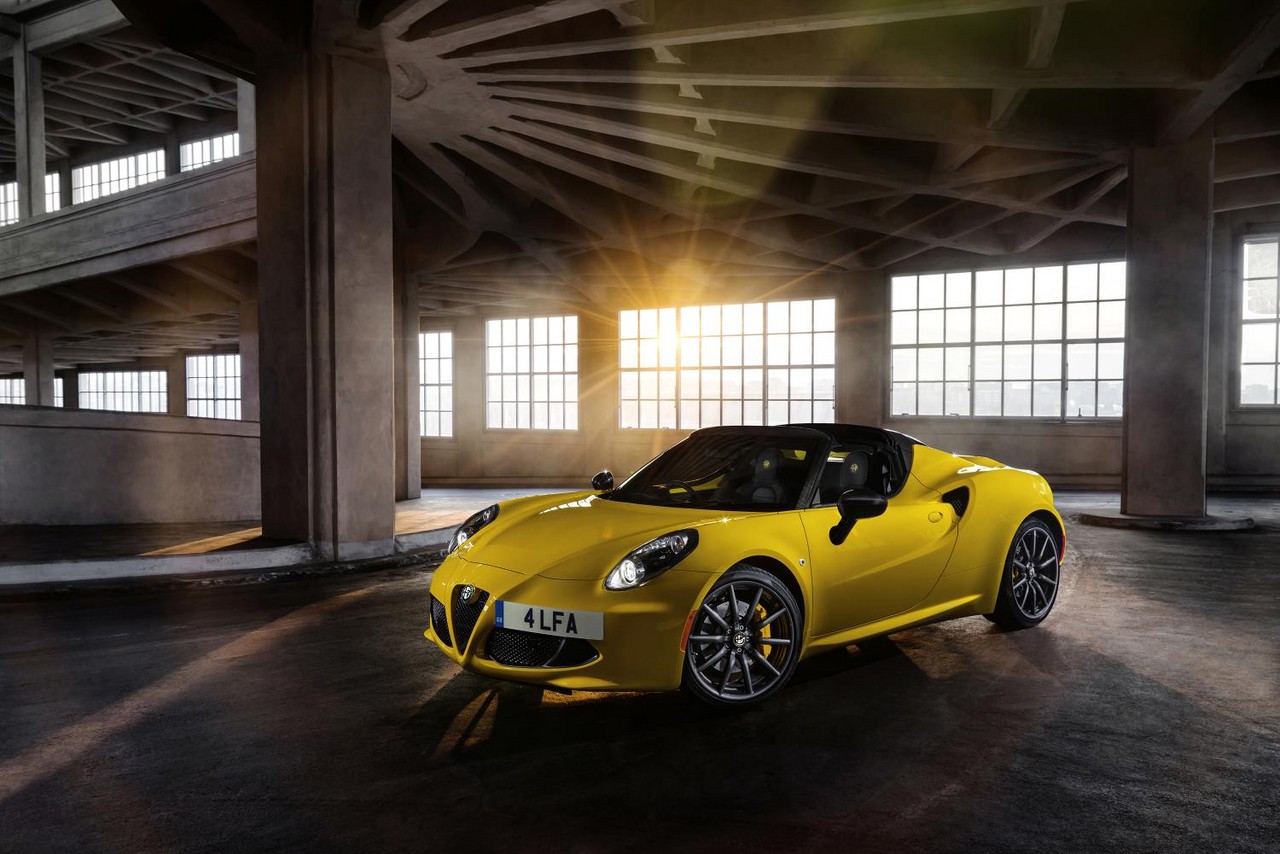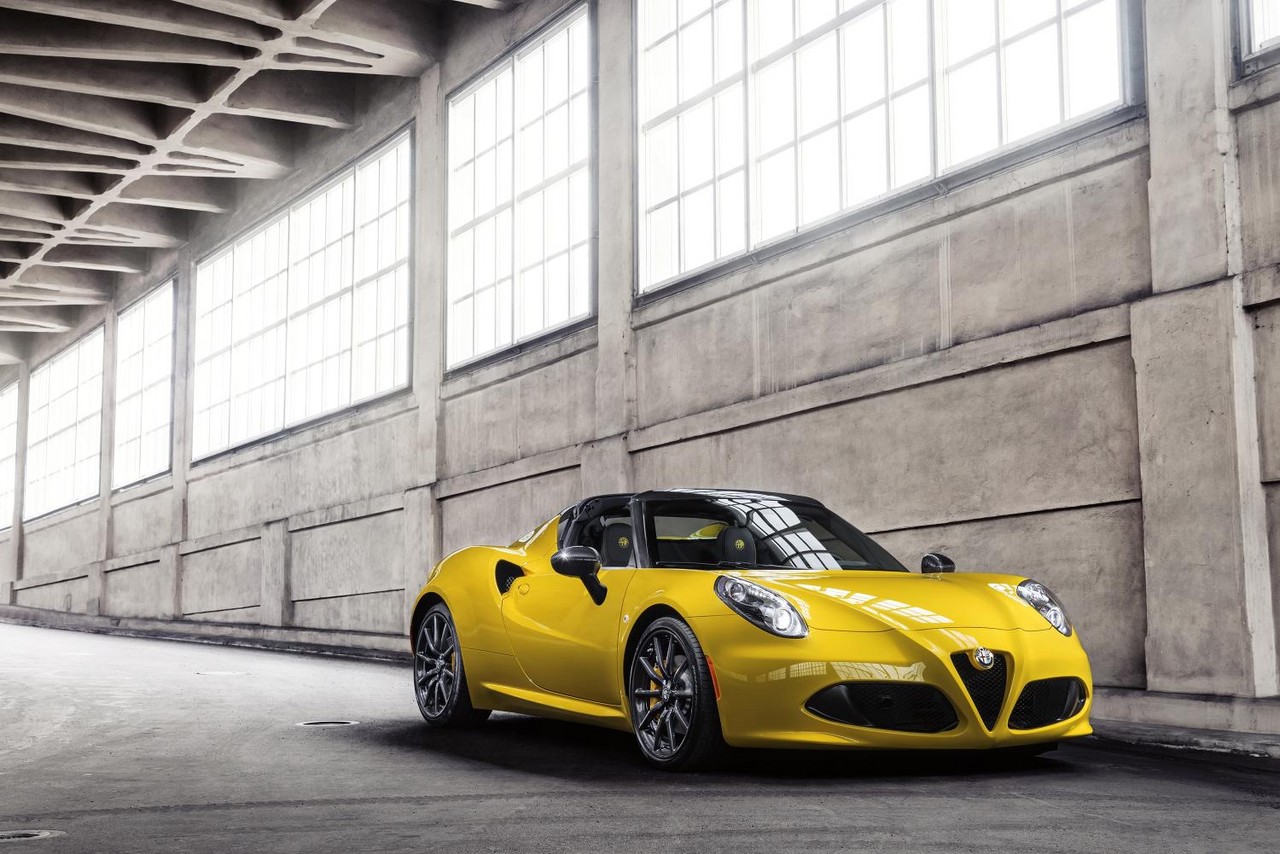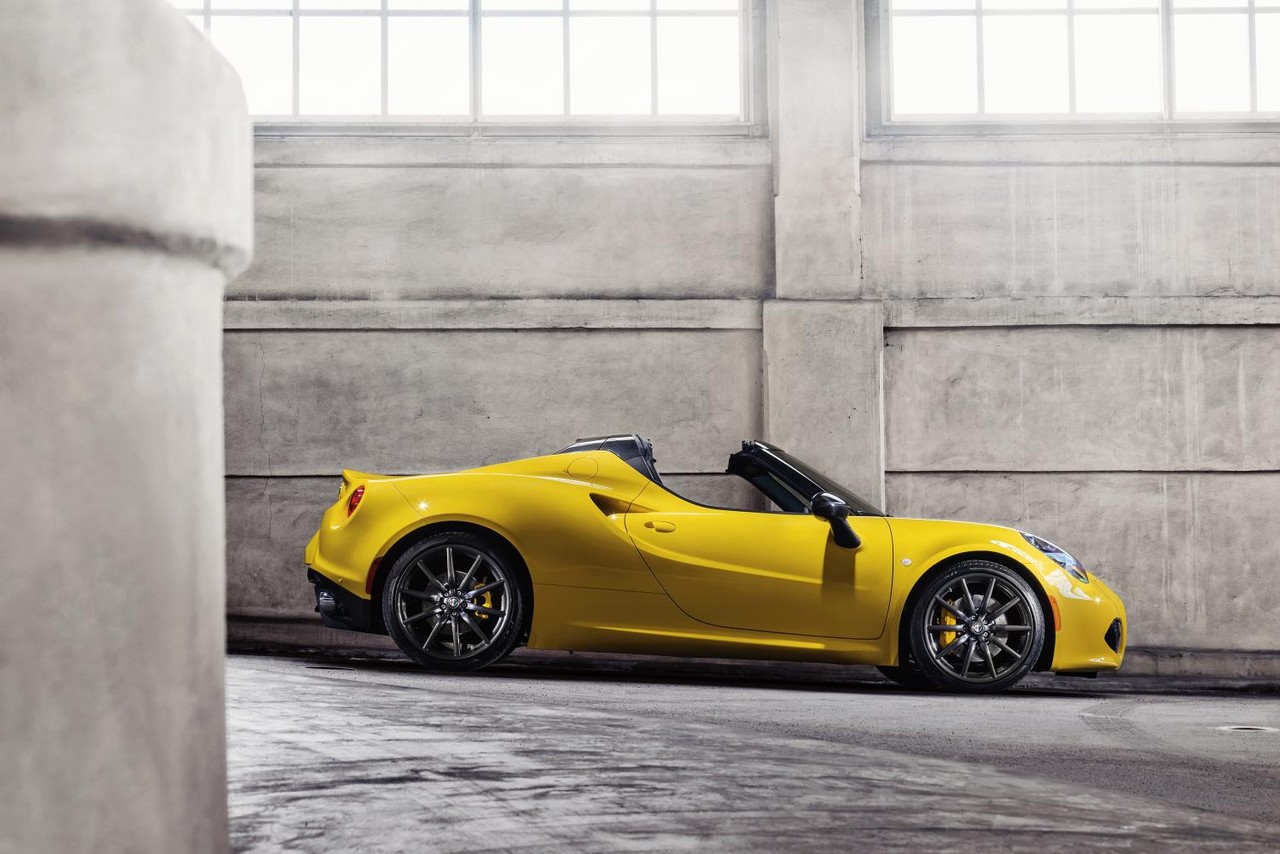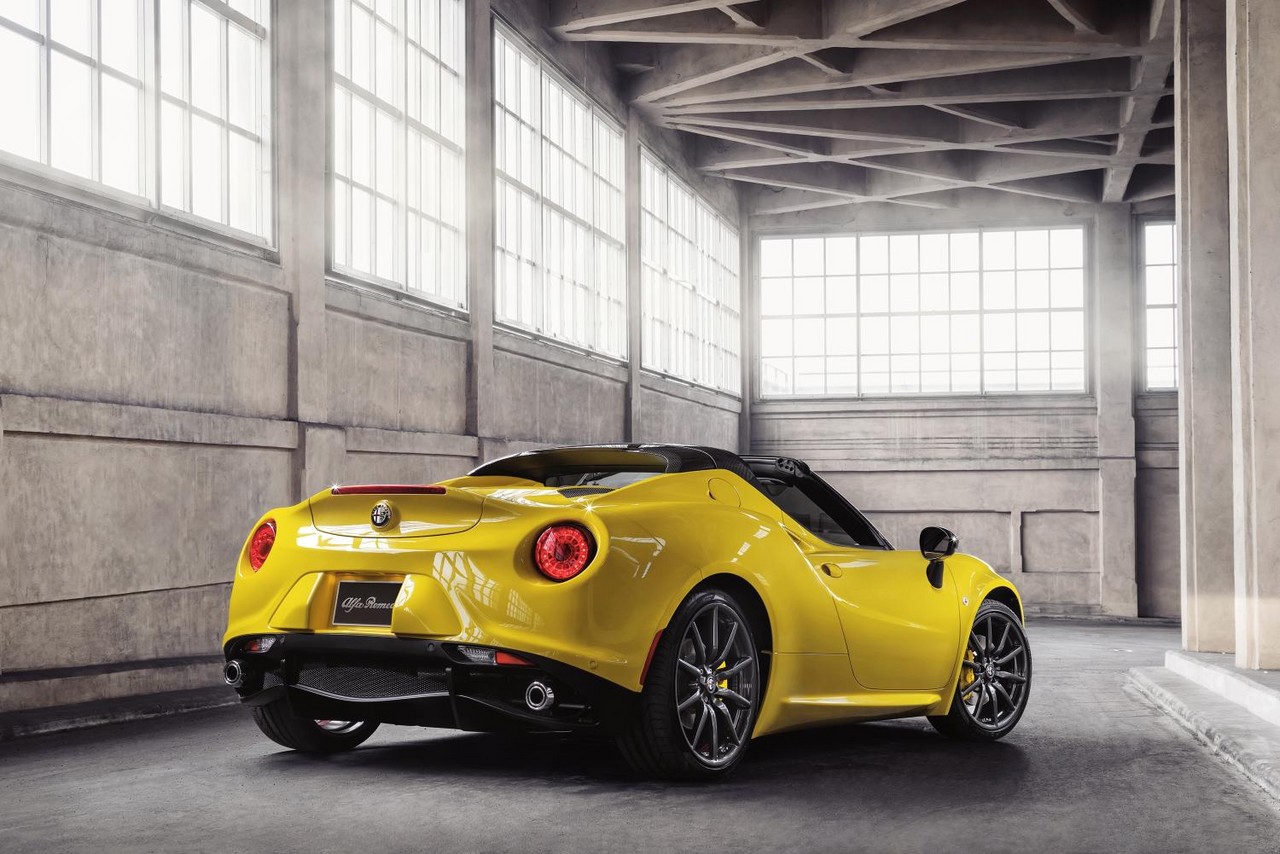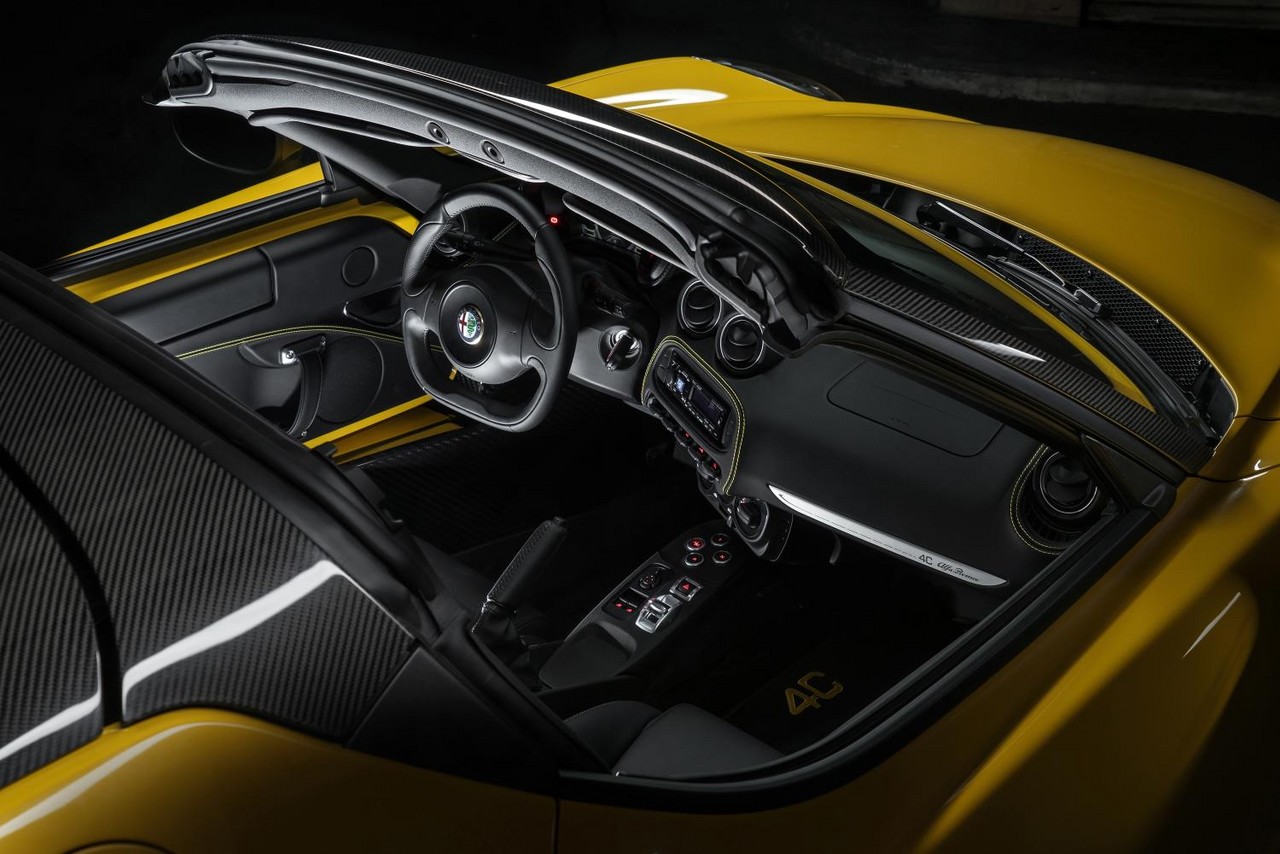
- Involving handling
- Tactile steering
- Lightweight carbon-fibre body
- Firm seats
- Lack of power steering can be a chore
- Distinct lack of storage
Overview
Released in Australia in December 2015, the Alfa Romeo 4C Spider is a two-seat convertible with a removable targa roof; the 4C Coupe has been reviewed separately. Manufactured at Maserati’s Modena plant, the mid-engined and rear-wheel drive Alfa Romeo 4C Spider is powered by a 1.75-litre turbocharged four-cylinder petrol engine that is mated to a six-speed dry clutch transmission.
1750 Turbo Engine
Described as ‘an evolution’ of the 1.75-litre turbocharged petrol engine used in the Alfa Romeo Giulietta QV , the 4C Spider’s engine has an aluminium alloy block with cast-iron liners, an aluminium bedplate, an aluminum-alloy cylinder head, forged aluminium pistons, a forged steel crankshaft with eight counterweights, direct fuel injection (operating at up to 200 bar), double overhead camshafts, four valves per cylinder, a turbocharger which provided peak boost pressure of 1.45 bar (21.75 psi), a pulse converter exhaust manifold that harnessed pressure waves to increase torque at low engine speeds, a wastegate valve, dual continuous variable valve timing, unique intake and exhaust systems, and a compression of 9.25:1.
| Engine | Trans. | Peak power | Peak torque | |
|---|---|---|---|---|
| 4C Spider | 1.75-litre turbo petrol I4 (939 B 1000) |
6sp DCT | 177 kW at 6000 rpm | 350 Nm at 2200-4250 rpm |
Twin clutch transmission (DCT)
The dual dry clutch transmission has automatic and sequential gearshift modes with the latter operated via steering wheel gearshift paddles. Furthermore, the Alfa Romeo ‘DNA’ selector provides selectable Dynamic, Natural, All Weather and Race modes; a Launch Control function also enables high-performance standing starts. As such, the Alfa Romeo 4C Spider is able to accelerate from rest to 100 km/h in 4.5 seconds.
Body and dimensions
Like the 4C Coupe, the Alfa Romeo 4C Spider has lightweight monocoque that is produced from ‘pre-preg’ carbon-fibre layers that are hand-laid for stiffness and strength. According to Alfa Romeo, these materials and construction method enable a chassis that was three times stronger and seven times lighter than steel. The primary differences between the 4C Coupe and 4C Spider are:
- An aluminium rollover structure – housed in a black or optional carbon fibre ‘halo’ – which contains the attachment points for the removable, stowable cloth roof (or carbon fibre hardtop);
- A unilateral carbon fibre windscreen frame that is adhered and bolted to the monocoque chassis; and,
- A high-strength steel engine compartment cross beam to maximise torsional rigidity.
Like the Coupe, the panels for the 4C Spider are made entirely from SMC (sheet moulded compound), a low-density high-strength composite material that is 20 per cent lighter and more rigid than steel.
Dimensions for the 4C Spider are similar to the 4C Coupe, i.e. 3989 mm long, 1864 mm wide and with a 2380 mm long wheelbase, though the Spider is 5 mm taller at 1189 mm. To reduce mass, the 4C Spider’s windscreen and side windows use 10 percent thinner glass, for a 15 per cent mass reduction. The 4C Spider is understood to have a kerb weight of 1035 kg, 10 kg greater than the 4C Coupe.
Styling
Compared to the 4C Coupe, the 4C Spider is identifiable by its rear buttresses and body-coloured engine cover which includes three heat extractors; a ‘subtle’ rear spoiler is also fitted as standard. At the front, the 4C Spider has covered, projector-style xenon headlights.
Suspension and steering
The Alfa Romeo 4C Spider has:
- Double wishbone front suspension with high-strength steel tubular-control arms, aluminium knuckles and a tubular anti-roll bar; and,
- MacPherson strut rear suspension which includes shock absorbers with hollow piston rods and side-load springs, high-strength steel tubular-control arms and aluminium knuckles.
The Alfa Romeo 4C Spider has unassisted, rack-and-pinion steering.
Safety equipment
Standard safety equipment for the Alfa Romeo 4C Spider includes dual front airbags, ABS, cornering brake control, electronic stability control, traction control and front seatbelts with pretensioners and load limiters.
Braking package
The Alfa Romeo 4C Spider is expected to have 305 mm by 28 mm dual-cast, perforated front brake discs with fixed four-piston Brembo calipers and 292 mm by 22 mm perforated rear brake discs with dual opposing calipers.
Features: Alfa Romeo 4C Spider
Standard features for the Alfa Romeo 4C Spider include 17-inch front and 18-inch rear alloy wheels with 205/45 ZR17 88Y XL front and 235/40 ZR18 95Y XL rear Pirelli P Zero AR tyres, an Alfa Hi-Fi sound system with Alpine head unit, Bluetooth connectivity, air conditioning, sports seats with black leather trim, cruise control, bi-xenon headlights, LED tail-lights, rear parking sensors, a leather-wrapped steering wheel with gearshift paddles, remote central locking, power windows and mirrors, a height and reach adjustable steering wheel, digital instrument panel, instrument gauges (for turbo pressure, oil temperature and a G-meter), a 12 volt power socket, aluminium pedals and footrest, tyre pressure monitoring, an alarm and immobiliser.
As standard, the Alfa Romeo 4C Spider is fitted with an electronically-controlled ‘Q2’ rear differential.
Options: Akrapovic exhaust and carbon-fibre air intake
The 4C Spider is available with an optional Akrapovic dual-mode exhaust system which is made from titanium. The exhaust system consists of:
- Two centrally-mounted tailpipes;
- Computer-optimised asymmetrical mufflers with a dual mode exhaust valve system that can be controlled by the driver; and,
- A link pipe with resonator to eliminate in-cabin droning; and,
- Carbon-fibre exhaust tip bezels.
Furthermore, the 4C Spider is available with an optional carbon-fibre air intake system which is designed to provide additional transmission cooling for track use.
Related links
- Alfa Romeo Media: Alfa Romeo 4C Spider at the 2015 Geneva Motor Show
- Alfa Romeo Australia: Alfa Romeo 4C
- Wikipedia.org: Alfa Romeo 4C
